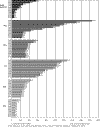|
|
AIR POLLUTION IN THE CZECH REPUBLIC IN 2002 Czech Hydrometeorological Institute - Air Quality Protection Division |
|
|
|
|
1. ATMOSPHERIC POLLUTANTS EMISSION IN THE CZECH REPUBLIC
Pursuant to the legislation valid until 2002 air pollution sources were divided into four categories to carry out emission inventories. Complying with this categorisation, the ISKO system operated by CHMI includes REZZO 1–4 databases (Register of Emissions and Air Pollution Sources) which serve for archiving and presenting data on stationary and mobile air pollution sources. The changes covering the division of sources pursuant to the Clean Air Act No. 86/2002 Coll. will be taken into account in processing the data for the year 2003. Large and medium-sized sources are monitored individually as point sources, small sources at local level as area sources and mobile sources as line sources (road transport in sections controlled by vehicle census) and as area sources at district level (other mobile sources). I. Large pollution sources - REZZO 1 The data used in the 2002 emission inventory of air pollutants from large sources was extracted from the summary operational inventory submitted by source operators to the Czech Environmental Inspection Office (ČIŽP) which is in charge of data collection and verification. Based on these data the REZZO 1 database has also been updated, i.e. constant and variable data on operation of air pollution sources (categorisation of sources, parameters, fuel consumption and emission quantity). The medium-sized sources category includes data on about 30,000 sources. On 1 January 2003 the authorities of basic administrative units with enlarged competencies took on the responsibilities connected with the charges and fees for emission pollution and verification of data of summary operational inventory of medium-sized sources. Emission inventory data for 2002 and data for REZZO 2 database will be submitted after the deadline of this Yearbook and, consequently, all emission data for the year 2002 in the tables are preliminary. Emissions from small sources (local heating units) have been inventoried based on the 1991 and 2001 General Census. Emission inventory is based on the model using updated data on climatic conditions, figures on heat consumption in household heating and consumption of particular fuel types calculated from them. Fuel composition is based on General Census information on the prevailing way of heating and on the used types of energy, updated annually according to data submitted by fuels and energy central suppliers. Inventories of emissions from transport, falling within the competency of the Ministry of Transport have been processed by the Transport Research Centre (CDV) Brno based on the method of determination of transport emissions. Emissions from agricultural and forest machines and other vehicles were calculated with the use of the data on sale and consumption of fuels for the year 2002. Table 1.1 documents total emissions of principal air pollutants in 2002, and namely, solid particles, SO2, NOx, CO and ammonia (NH3) and shares contributed by each of the emission source categories monitored to total air pollutant emissions. VOC emission inventory is recorded differently and it includes also estimates of emission quantity from the solvent use and paint application in sources not registered in REZZO database – outdoor and domestic paint and solvent use etc. Therefore only data on total VOC emission are presented (see Fig. 1.1). The development of total emission of principal pollutants in 1990–2002 is shown in Fig. 1.1. The development of emissions in the period 2000–2002 shows gradual stabilization of stationary sources and a slight decrease of emissions from mobile sources resulting from current car fleet renovation, especially in personal motor cars. The level of emissions should not markedly exceed the current values in the forthcoming years. Table 1.2 presents emissions of greenhouse gases with direct radiative absorbing effect for the period 1990–2001. The values shown in the table were recalculated to the equivalent amount of CO2 using the standard coefficients for the whole monitored period (1995 Global Warming Potential) defined for the 100-year time horizon, i.e. CO2 = 1, CH4 = 21, N2O = 310. The values of CO2 include also removals from forestry. Table 1.3 covers heavy metal (HM) and POPs emissions. The emission inventories were produced with the use of activity data (fuel and propellant consumption, incinerated waste quantity, statistical data on the production of selected technologies) and of the respective emission factors. In addition to Pb, Hg and Cd emissions presented until 2000 emissions of further monitored heavy metals were also calculated for the year 2001. The HM and POPs emission inventories are supplemented by data for less significant category of sources not monitored earlier. The methods of HM and POPs emissions calculation and estimates are verified pursuant to internationally recommended procedures. Table 1.4 demonstrates the consumption development of principal fuels in the period 1990–2001. A trend of marked decrease in brown coal and residual oil consumption by large emission sources contributed to a long-term decline in SO2 and particulates, mainly in the 1990–1997 period. The development of consumption of principal fuels of REZZO 3 sources between 1990 (data based on the inventory carried out by TECO Milevsko) and 2002 is shown in Fig. 1.2. Changes in residential heating in 1991 (data provided by General Census) and 2002 (updated situation) are shown in Fig. 1.3. Emission data processed into charts with the help of GIS is shown in Figs. 1.4, 1.5, 1.6 and 1.7. Emission densities for solid particles, SO2, NOx and VOC are plotted in 5 x 5-km grid-squares. The charts are based on current emissions from stationary sources (REZZO 1 to 3) and mobile sources (REZZO 4) for 2001, with regional disaggregation of emissions from line sources according to the 1995 vehicle census. Among the most polluted regions of the Czech Republic with regard to emissions of principal air pollutants are counted continuously the region of the Capital City of Prague, Ústí nad Labem Region and the Moravian-Silesian Region. Comparison of the specific emissions in particular regions in 1990 and 2001 (Table 1.5 and Table 1.6) shows that in case of this coefficient expressive improvements occurred, especially reduction of SO2 and particulate emission. Tab. 1.1 Total emissions of principal air pollutants in 2002 – preliminary data Tab. 1.2 Total emissions of greenhouse gases, 1990 to 2001 Tab. 1.3 Total emissions of HMs and POPs between 1990 and 2001 Tab. 1.4 Fuel consumption in REZZO 1 sources between 1990 and 2001 Tab. 1.5 Specific emission from stationary sources (data for REZZO 4 were estimated), 1990 Tab. 1.6 Specific emission from stationary sources in 2001 Fig. 1.1 Total emissions of principal pollutants in the Czech Republic between 1990 and 2002 Fig. 1.2 Fuel consumption in REZZO 3 sources, 1992–2002 Fig. 1.3 Changes in residential heating in 2002 as compared to 1991 Fig. 1.4 Particulate emission density from 5x5 km squares, 2001 Fig. 1.5 Sulphur dioxide emission density from 5x5 km squares, 2001 Fig. 1.6 Nitrogen oxide emission density from 5x5 km squares, 2001 Fig. 1.7 CxHy emission density from 5x5 km squares, 2001
|






